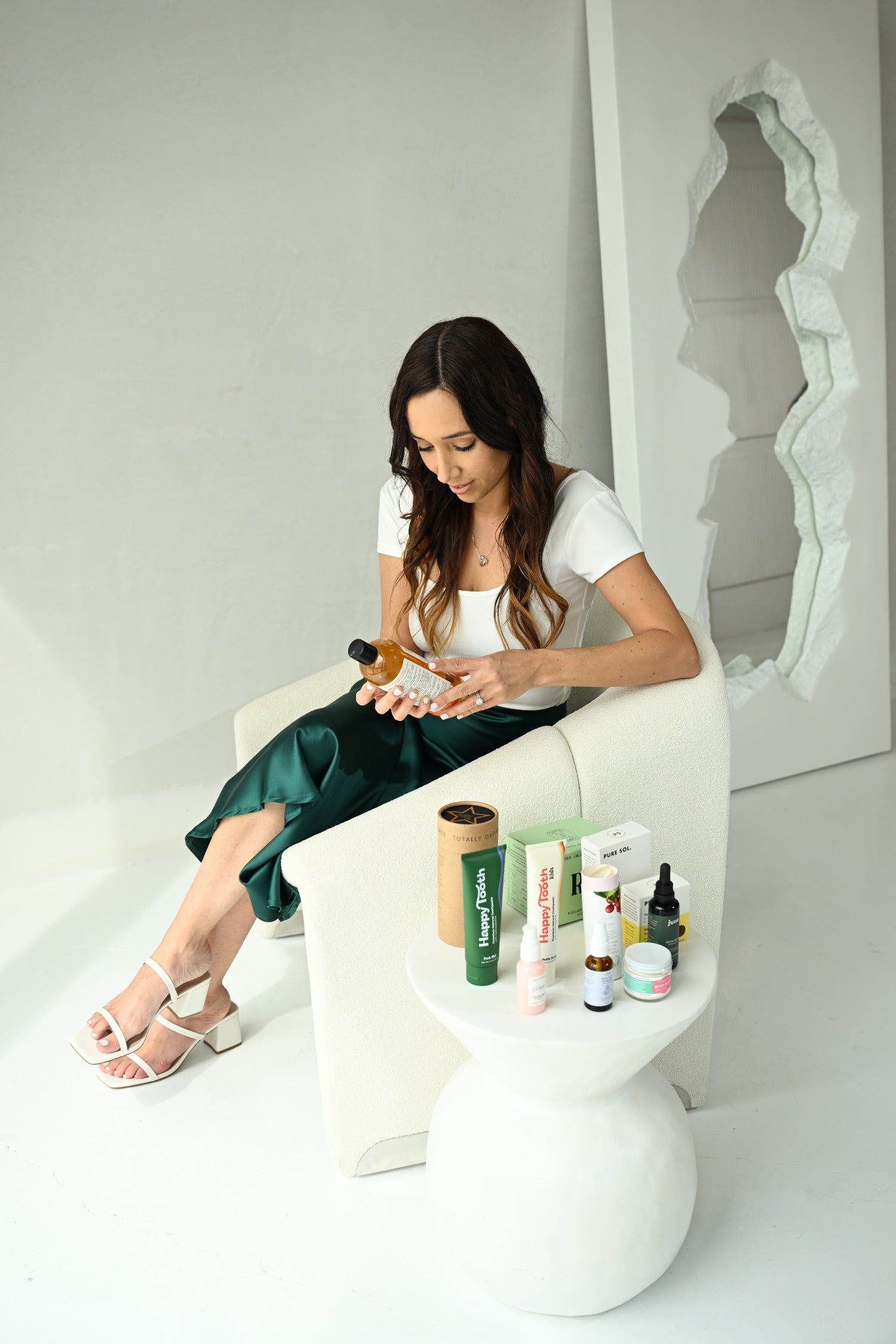If you've ever struggled with breakouts after trying a new skincare product, you may have come across the term "comedogenic rating." But what does it really mean? And can it help you avoid pore-clogging ingredients? In this quick and practical guide, we break down everything you need to know about the comedogenic rating scale, how it works, and how to apply it to your clean beauty routine.
What Is The Comedogenic Rating Scale?
As someone who has always struggled with hormonal acne, I am often seeking out non-comedogenic products. And as I formulate products for Organic Ivy, this is something that is top of mind.
The comedogenic rating scale is a 0 to 5 numerical scale that ranks ingredients based on their likelihood of clogging pores and contributing to acne. Originally developed through rabbit ear testing (a method now considered outdated and ethically questionable), the scale is still widely used as a reference point for acne-prone individuals.
The Scale Explained:
- 0 = Non-comedogenic (Will not clog pores)
- 1 = Slightly comedogenic (Low chance of clogging pores)
- 2 = Mildly comedogenic (Some risk for sensitive/acne-prone skin)
- 3 = Moderately comedogenic (Can clog pores in some individuals)
- 4 = Fairly high risk (Often clogs pores for many people)
- 5 = Highly comedogenic (Very likely to clog pores)
Keep in mind: These numbers are not absolutes. Ratings are highly subjective and there is no universal standard. Skin type, skin health, and formulation context all matter. Each individual ingredient in a formula will have its own comedogenic rating, and then the formula overall would have its own depending on the combination and concentration of the ingredients.
Both natural and synthetic ingredients can be high on the comedogenic rating scale. Let's discuss.
What Makes An Ingredient Comedogenic?
The tendency to clog pores often comes down to the ingredient's fatty acid composition, molecular weight, and occlusive nature:
- Fatty acids like oleic acid are more likely to cause breakouts in acne-prone skin due to their thick, rich texture. Every single oil has a fatty acid profile that gives us clues on how comedogenic it will be.
- High molecular weight oils may sit on the skin and trap debris or bacteria.
- Occlusives create a barrier that can be helpful for dry skin but are sometimes problematic for those prone to clogged pores, particularly if you are trapping bacteria under the occlusive layer.
Linoleic acid-rich oils (like rosehip and hemp seed oil) tend to be better tolerated by acne-prone skin.
The comedogenic rating of an ingredient can also change depending on how it's processed (cold-pressed vs. refined) and what it's blended with. For example, cold-pressed oils retain more of their natural fatty acid profile and antioxidant content, but they may also contain larger molecules that can clog pores more easily in some individuals. On the other hand, refined oils go through a process that removes many compounds, which can sometimes reduce their comedogenicity—but may also strip away beneficial nutrients.
In short, even the same ingredients can contain different comedogenic ratings depending on its processing. Coconut Oil is a great example of this. Unrefined Coconut Oil is usually around a 4. Fractionated Coconut Oil may land around a 2-3, and Caprylic/Capric Triglycerides are a 0-1. All 3 of these ingredients come from Coconut Oil, but they have been processed to remove certain fatty acids along the way, which changes its comedogenic rating.
Natural Ingredients With High Comedogenic Ratings
Here are natural ingredients we often spot in "clean products", with their estimated comedogenic ratings.
Note: Because there is no standard rule, we pulled these ratings by looking at publications, blogs and skincare forums, and, on average, here is where these ingredients land:
- Algae Extract – 5
- Avocado Oil – 2–4
- Carrageenan (Red Algae) – 5
- Coconut Oil – 4
- Cocoa Butter – 4
- Cottonseed Oil – 3–4
- Flaxseed (Linseed) Oil – 4
- Lanolin – 4
- Moringa Oil – 4
- Palm Oil – 4
- Red Algae – 5
- Peach Kernel Oil – 4
- Sesame Oil – 3–4
- Soybean Oil – 4–5
- Wheat Germ Oil – 5
Synthetic Ingredients With High Comedogenic Ratings
Synthetic and petro-derived ingredients tend to be less comedogenic than natural ingredients because of how highly refined they are. For example, mineral oil and petrolatum actually have a comedogenic rating of 0. This, of course, does not mean we advocate for petro-ingredients, but it is one of the reasons acne products are often filled with them.
Still, there are a few synthetics with pore-clogging risks. These are among the most problematic:
- Acetylated Lanolin – 4
- Acetylated Lanolin Alcohol – 4
- Algin (Alginic Acid) – 4
- Butyl Stearate – 4
- Ceteareth-20 – 4
- Decyl Oleate – 4
- Ethylhexyl Palmitate
- Glyceryl-3-Diisostearate – 4
- Hexadecyl Alcohol – 5
- Isopropyl Myristate – 5
- Isopropyl Palmitate – 4
- Isopropyl Isostearate – 5
- Isocetyl Stearate – 5
- Laureth-4 – 5
- Myristyl Myristate – 5
- Octyl Palmitate – 4
- Octyl Stearate – 5
- Oleth-3 – 5
- PEG 16 Lanolin – 4
- Polyglyceryl-3-Diisostearate – 4
- Potassium Chloride – 5
- Propylene Glycol Monostearate – 4
- Red Dyes (D&C Red Dyes) – 4–5 (Note: Certain coal tar-derived dyes have been found to be comedogenic)
- Sodium Lauryl Sulfate – 5
- Sodium Chloride (Salt) – 5
- Steareth-10 – 4
Can You Estimate a Product's Comedogenic Rating?
- List out all oils, butters, and fatty ingredients and look up the comedogenic rating of each.
- Note how high up they appear in the ingredient list - Ingredients are required to be listed in order from high to low concentration. Meaning if the ingredient is higher on the list, then its comedogenic rating is going to affect most of the formula. Unfortunately, it's not as simple as taking a weighted average, but high comedogenic-rated products earlier in the ingredient list tells you it might be pore clogging.
- Consider your skin type. Drier skin may tolerate a 2–3 rating better than oily or acne-prone skin.
Comedogenic ratings are best treated as guidelines, not hard rules—your personal skin type, the formula’s context, and how a product is used all play a role in the final effect.
Are Comedogenic Ratings An Exact Science?
Unfortunately, no. As you've already read, the ratings themselves are very subjective and there is no universal standard or rule. To make matters even more complicated, seldomly do you find just a single ingredient product, so you also have to consider how the ingredients interact with each other–and it's not as simple as taking a weighted average of the comedogenic rating.
Still, they can be useful tools in identifying products that may be too much for an acne-prone individual to handle. By learning what works for your unique skin and understanding the science behind the numbers, you can build a skincare routine that truly supports your goals.
Remember that our skin replaces itself every 28 days on average (gets longer as we age). It's typically best to try a new skincare product for a full month before judging its effect on your skin. If you're a woman, this also allows you to experience the product through all phases of your menstrual cycle, which plays a huge role in how your skin behaves (ie. hormonal breakouts, etc.).





